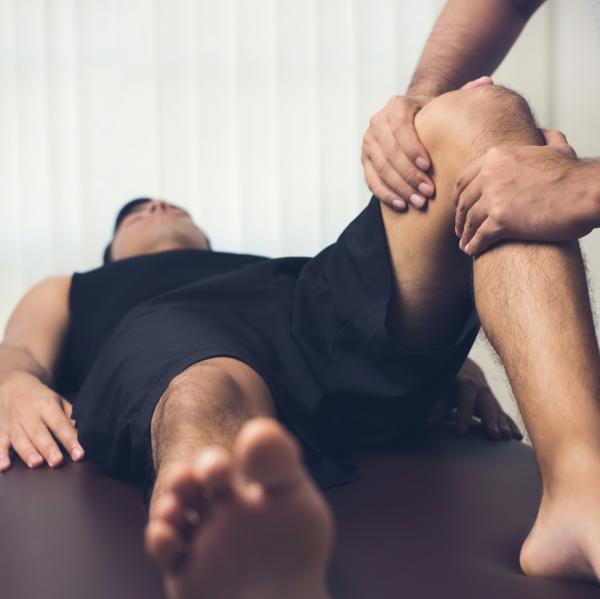Understanding Injuries of the MCL in Hockey

Contributions by: Andrew Grahovec and Katie Christopherson, ATC
To compete at the professional level in any sport requires the most athletic, highly skilled and mentally acute individuals in the world. With constant training, practice and exhibitions throughout a season, pushing your body to the utmost physical limits can take a toll on the body over time. In ice hockey, players, by nature, are regarded as some of the toughest athletes on a mental and physical level. As one of the fastest sports, the conditions during play are dangerous and require sharp focus, balance and grit to compete at a high level. With the speed and physicality of the game, the risk of injury is significantly increased. It’s no surprise that one of the most common types of injuries sustained during play involve the knees.
To get a better feel for the inner workings of the MCL (Medial Collateral Ligament) and MCL injury insight, we teamed up with ATI athletic trainer and hockey injury expert, Katie Christopherson.
The Role of the MCL in Hockey
Considered one of the four primary stabilizing ligaments in the knee, the MCL is the innermost ligament of the knee designed to protect the knee joint’s stability and strength. It also plays a key role in preventing the leg from over-extending inward. For hockey players, the MCL is crucial in helping the knee manage the on-ice demands of skating, planting for contact and more.
Common MCL Inury Symptoms
When an MCL becomes injured, you may experience pain on the inside edge of the knee, along with swelling and tenderness. Several hours after the injury, this discomfort may be coupled with difficulty moving and increased levels of pain. It’s also not uncommon to feel a ‘loose or wobbly’ feeling in the knee when walking. At this point, we recommend getting in touch with your primary doctor or local physical therapist to further assess the injury.
Grades of MCL injuries
Since the MCL's primary role is preventing the leg for overextending inward, naturally, it assumes a substantial amount of the body's weight. Because of this, an athlete is more susceptible and likely to experience an injury to the MCL, rather than the LCL (Lateral Collateral Ligament), which is located on the outer side of the knee – opposite of the MCL.
MCL injuries are classified according to three different grades including:
· Grade 1 (minor): results from a force strong enough to stretch the ligament, but not tear it.
· Grade 2 (moderate): stretched ligament with some tearing involved
· Grade 3 (severe): completely torn ligament – and most sever of the three grades
Common Types of Hockey Ankle Sprains
Given the fast-paced, high-contact nature of the sport, hockey players are at an increased risk of injuring their lower body structures. When looking at the MCL specifically, it’s more common to see Grade 1 MCL injuries resulting from less abrasive blows to the knee or mild twisting motions at the knee. For Grade 2 and 3 MCL injuries, we tend to attribute those to the more nefarious blows or extreme twists to the outside of the knee, which still happen, but not as often as the former.
Treatment for a Sprained MCL
Among the three grades, a Grade 1 treatment is a more straightforward than the others. A Grade 1 sprain can take typically one to two weeks to heal, whereas a Grade 2 and 3 injuries may take two to four weeks and four to eight weeks, respectively. In rehabbing an MCL sprain or tear, your physical therapist or doctor first determines the grade of the injury and the effect it has on the knee during weight-bearing (the body’s ability to resist or support weight). They’ll also note how the knee joint moves through flexion (bending motion) and extension and how that force displacement is on the MCL. This will ultimately decide what treatments and strengthening methods to use.
Early MCL Sprain Rehab
Initially, an athlete’s treatment should consist of pain-free, range of motion exercises, such as knee slides on the table, wall slides, assisted slides and riding a stationary bike. As pain subsides and range of motion increases, this usually indicates that an athlete is ready to incorporate flexion and extension exercises - like open-chain strengthening (hands or feet are not in a fixed position). But that’s not to say that an athlete should shy away from closed-chain strengthening (hands or feet are in a fixed or stationary position), as these are also effective exercises to build into a program.
Advanced MCL Sprain Rehab
Once an injured athlete progresses to the more advanced stages of rehabilitation, a concentration on functional activity will be introduced. This may include plyometric exercises and functional activities to ensure dynamic stability of the knee. At this stage, a great tool for rehabbing a hockey player is a slide board, which is a slick surface that can mimic the motion of the athlete's leg on ice.
MCL Physical Therapy at ATI
ATI experts strongly encourage athletes to take care of any minor aches and pains before they compound and get worse. This can be as simple as heating for 20 minutes before activity and icing for 20 minutes after activity when the athlete feels soreness in one particular area. If the pain persists, it might be a good idea to call your physician or visit your nearest ATI physical therapy clinic. In fact, at ATI, we offer complimentary injury screenings, so stop in and see what we can do for you.
